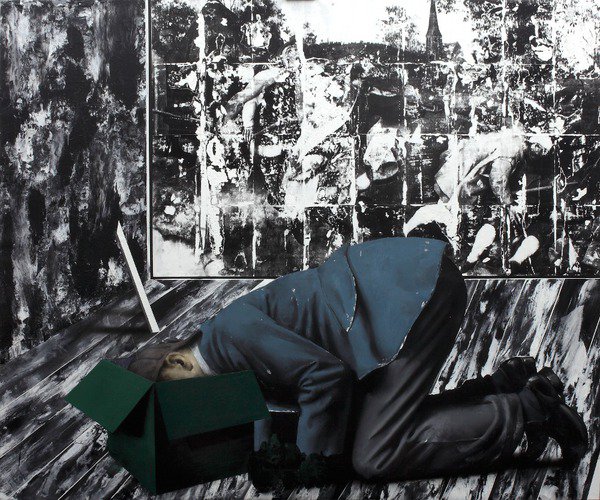Romanian Scenes
dal 10/10/2013 al 11/1/2014
Segnalato da
Ioana Batranu
Dan Beudean
Mihuț Boșcu Kafchin
Geta Bratescu
Simon Cantemir Hausi
Oana Farcas
Adrian Ghenie
Ion Grigorescu
Ciprian Muresan
Sergiu Toma
Mircea Suciu
Serban Savu
Bogdan Vladuta
Herve' Mikaeloff
10/10/2013
Romanian Scenes
Espace culturel Louis Vuitton, Paris
The exhibition features a selection of works by artists who have marked the art scene over the past forty years. Paintings of bygone eras -symbols of the resistance to the dictatorship's oppression- are like so many reinvented images that, despite exacerbated globalization, continue to have a potent impact.

curated by Hervé Mikaeloff
Artists: Ioana Batranu, Dan Beudean, Mihuț Boșcu Kafchin, Geta Bratescu, Simon Cantemir Hausi, Oana Farcas,
Adrian Ghenie, Ion Grigorescu, Ciprian Muresan, Sergiu Toma, Mircea Suciu, Serban Savu and Bogdan Vladuta.
Romanian Scenes is the latest in a series of exhibitions whose origins date to the founding of the Espace culturel
Louis Vuitton in 2006; each has explored the contemporary art scene of a foreign country. This year, the Espace has
chosen to showcase the artistic experiments of a country that has always been a fertile land for creative expression:
Romania. During the years of political oppression, the work of Romanian artists remained experimental and confidential;
but once this period came to an end, they were quick to assert their identity, bursting onto the international art scene.
Today, they are a notable presence: from Berlin to London, New York to Paris. Between the public sphere and
introspection, they were able to resist all forms of control and retain the characteristics that make them unique.
With open minds, the Espace culturel Louis Vuitton set off for Bucharest and Cluj Napoca to meet men and women
who were to introduce us to a new state of painting. A selection of works by artists who have marked the art scene over
the past forty years has been brought together. The past and the future stand comfortably in one another’s presence
and imagery reigns. Paintings of bygone eras –symbols of the resistance to the dictatorship’s oppression– are like
so many reinvented images that, despite exacerbated globalization, continue to have a potent impact. An older
generation of artists in Bucharest maintained a truly vibrant creative energy from the dark years and has passed
this torch on to their successors. Geta Bratescu, a major figure on the post-war Romanian art scene, evokes the theme
of travel in a series of drawings based on the principle of stream-of-consciousness writing; Ion Grigorescu bears witness
to a bygone era through drawings and photographs; Ioana Batranu paints abandoned interiors hinting at the paradoxical
splendor of a troubled past; Bogdan Vladuta, an artist from the new generation, creates near-monochromatic urban
worlds in which a kind of impalpable mysticism is expressed.
In Cluj, the young generation of artists has adopted academic painting techniques and then taken them across
unexpected frontiers to places where hyperrealism and oneiric worlds collide. Dan Beudean uses graphite
to turn the mythical characters in his works into icons; Mihuț Boșcu Kafchin creates a giant-scale universe where reality
is plunged into science-fiction; Simon Cantemir Hausi covers his tracks in his portraits and landscapes so well that
they verge on abstraction; Oana Farcas bathes the gentle strokes of her paintings in light that seems almost supernatural;
Ciprian Muresan adapts works of literature as a means to examine Romania’s recent history through his drawings; Sergiu
Toma takes viewers of his works on a mysterious, nostalgic journey, full of phantasmagorical symbols; Serban Savu
paints the seeming banality of Romanian society that he scrutinizes from the window of his studio; Mircea Suciu dresses
social criticism in an off-beat, subversive universe; and last but not least, Adrian Ghenie uses portraits to explore essential
issues surrounding power and oppression while playing with clichés related to the history of entertainment. In short,
while there is no Cluj School as such, the city has been a breeding ground for artists who have succeeded in asserting
both their identity and the originality of their style. Their work results from the ebb and flow between the Inner (themselves)
and the Outer (the world), respecting a balance that preserves the strength and vigor of the author.
Image: Mircea Suciu, Leading the blind, 2013. Oil, acryl, toner, charcoal, ink on canvas, 196 x 233 cm. Courtesy: Private Collection
Press contact: Jun Fujiwara T. + 33 1 55 80 33 80 j.fujiwara@fr.vuitton.com
Young Visitors contact: Aurélia Bismuth a.bismuth@fr.vuitton.com
T. +33 1 53 57 53 77
Espace culturel Louis Vuitton
60, rue de Bassano - 101, avenue des Champs-Élysées - 75008 Paris
Open Monday to Saturday from 12pm to 7pm, Sunday from 11am to 7pm.
Open on public holidays, with the exception of 25th December, 1st January and 1st May.



